Clean and Efficient Recovery of Lithium from Al-Li Alloys via Vacuum Fractional Condensation
Abstract
1. Introduction
2. Theoretical Analysis and Experimental Methods
2.1. Boiling Point and Saturated Vapor Pressure of Pure Metals
2.2. Separation Factor and Gas–Liquid Equilibrium Composition Diagram of Binary Alloy
2.3. Lithium Vapor Condensation Rate
2.4. Nucleation and Condensation of Lithium Vapor
2.5. Experimental Details
3. Results and Discussion
3.1. Theoretical Results
3.2. Condensation Law of Pure Li
3.3. Vacuum Distillation Condensation of Al-Li Alloy
4. Conclusions
Author Contributions
Funding
Data Availability Statement
Conflicts of Interest
References
- Zhang, M.L.; Yan, Y.D. Lithium and Lithium Compounds; Science Press: Beijing, China, 2015; pp. 10–22. [Google Scholar]
- Qiao, Z.Y. Handbook of Rare Metal; Metallurgical Industry Press: Beijing, China, 1992; pp. 11–18. [Google Scholar]
- Atkins, P.W. Physical Chemistry; Oxford University Press: Oxford, UK, 2014; pp. 25–58. [Google Scholar]
- Sverdlin, A.; Drits, A.M.; Krimova, T.V. Aluminum-lithium alloys for the aerospace. Adv. Mater. Process. 1998, 153, 49–52. [Google Scholar]
- Babel, H.; Gibson, J.; Tarkanian, M.; Parrish, C.; Prietto, M.; Ordonez-Chu, A.; Haberl, H.; Kabisch, J.; Clark, R.; Ogrenet, J.; et al. 2099 aluminum-lithium with key-locked inserts for aerospace applications. J. Mater. Eng. Perform. 2007, 16, 584–591. [Google Scholar] [CrossRef]
- Zeng, M.; Wang, S.C.; Duan, J.H.; Sun, J.H.; Zhong, P.Y.; Zhang, Y.J. Review of nuclear power development in China: Environment analysis, historical stages, development status, problems and countermeasures. Renew Sust Energ Rev. 2016, 59, 1369–1383. [Google Scholar] [CrossRef]
- Xie, Q.; Li, W.; Manthiram, A. A Mg-doped high-nickel layered oxide cathode enabling safer, high-energy-density Li-ion batteries. Chem. Mater. 2019, 31, 938–946. [Google Scholar] [CrossRef]
- Yamada, A.; Chung, S.C.; Hinokuma, K. ChemInform Abstract: Optimized LiFePO4 for Lithium Battery Cathodes. ChemInform 2010, 32. [Google Scholar] [CrossRef]
- Arnold, A.; Sauermann, R.; Friedrich, B. Recycling of Li-containing aluminum alloys. Light Met. Age 2011, 69, 32–37. [Google Scholar]
- Collins, B.D.; Jibson, R.W. Assessment of Existing and Potential Landslide Hazards Resulting from the April 25, 2015 Gorkha, Nepal Earthquake Sequence; US Geological Survey: Menlo Park, CA, USA, 2015. [CrossRef]
- Ostroushko, Y.I. Lithium, Its Chemistry and Technology; US Atomic Energy Commission, Division of Technical Information: Washington, DC, USA, 1962.
- Smeets, A.A.J.; Fray, D.J. Extraction of lithium by vacuum thermal reduction with aluminum and silicon. Trans. Inst. Min. Metall. Sect. C-Miner. Process. Extr. Metall. 1991, 100, 42–55. [Google Scholar]
- Chen, W.L. Research on Vacuum Refining of Lithium and Preliminary Study on Vacuum Carbothermal Reduction of Lithium Oxide; Kunming University of Science and Technology: Kunming, China, 2000. [Google Scholar]
- Lee, H.J.; Cagin, T.; Goddard, I.W.A.; Johnson, W.L. Molecular dynamics simulations of glass formation and crystallization in binary liquid metals. J. Metastable Nanocryst. Mater. 2003, 15–16, 181–186. [Google Scholar] [CrossRef]
- Kluge, M.D.; Ray, J.R.; Rahman, A. Amorphous-silicon formation by rapid quenching: A molecular-dynamics study. Phys. Rev. B 1987, 36, 4234–4237. [Google Scholar] [CrossRef] [PubMed]
- Holender, J.M. Molecular-dynamics studies of the thermal properties of the solid and liquid fcc metals Ag, Au, Cu, and Ni using many-body interactions. Phys. Rev. B 1990, 41, 8054–8061. [Google Scholar] [CrossRef] [PubMed]
- Gale, W.F.; Totemeier, T.C. Smithells Metals Reference Book; Elsevier Press: Amsterdam, The Netherland, 2003. [Google Scholar]
- Herrmann, H.; Bucksch, H. Dictionary Geotechnical Engineering/Wörterbuch GeoTechnik: English-German/Englisch-Deutsch; Springer: Berlin/Heidelberg, Germany, 2014; p. 229. [Google Scholar]
- Yang, C.C.; Li, J.C.; Jiang, Q. Effect of pressure on melting temperature of silicon determined by Clapeyron equation. Chem. Phys. Lett. 2003, 372, 156–159. [Google Scholar] [CrossRef]
- Surhone, L.M.; Tennoe, M.T.; Henssonow, S.F. Antoine Equation; Betascript Publishing: Beau Bassin, Mauritius, 2011. [Google Scholar]
- Dai, Y.N.; Yang, B. Vacuum Metallurgy of Non-Ferrous Metals; Metallurgical Industry Press: Beijing, China, 2009; pp. 508–514. [Google Scholar]
- Shi, L.; Jia, L.; Ning, P.; Sun, X.; Wang, C.; Ma, Y.X.; Wang, F.; Qu, T.; Li, K. Vacuum distillation and ab initio molecular dynamic simulation of Al–Li alloys. Vacuum 2023, 210, 111877. [Google Scholar] [CrossRef]
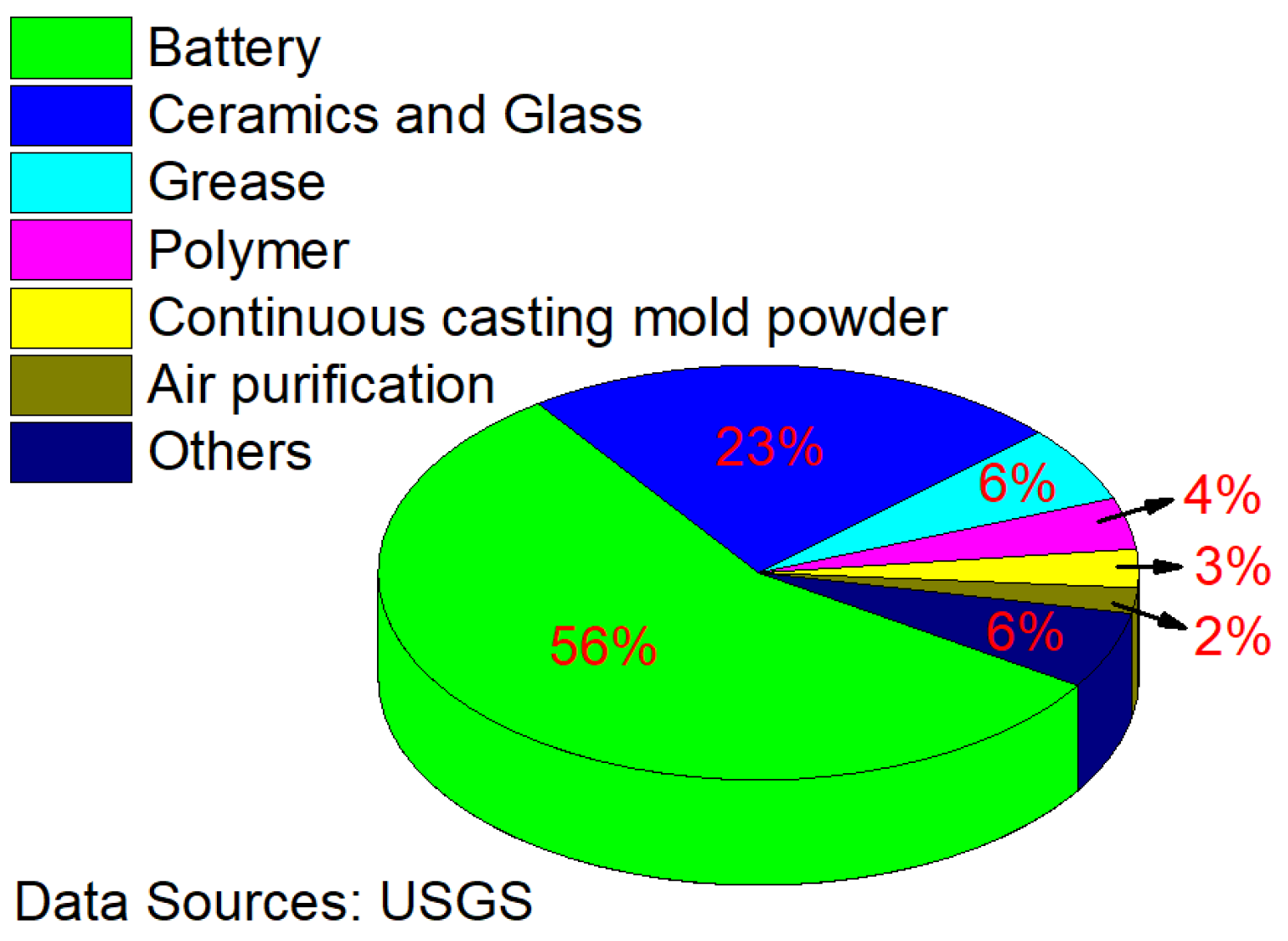

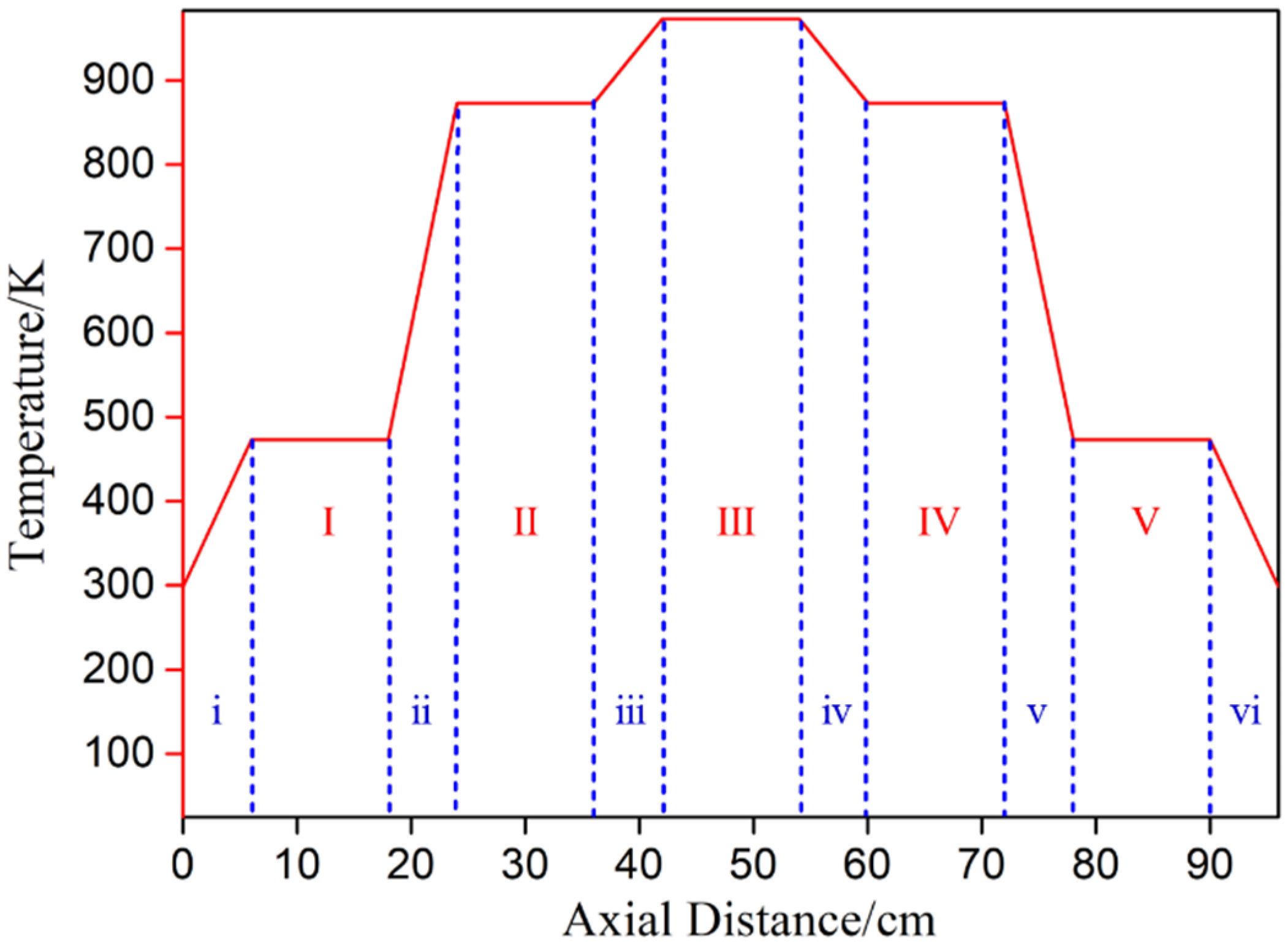
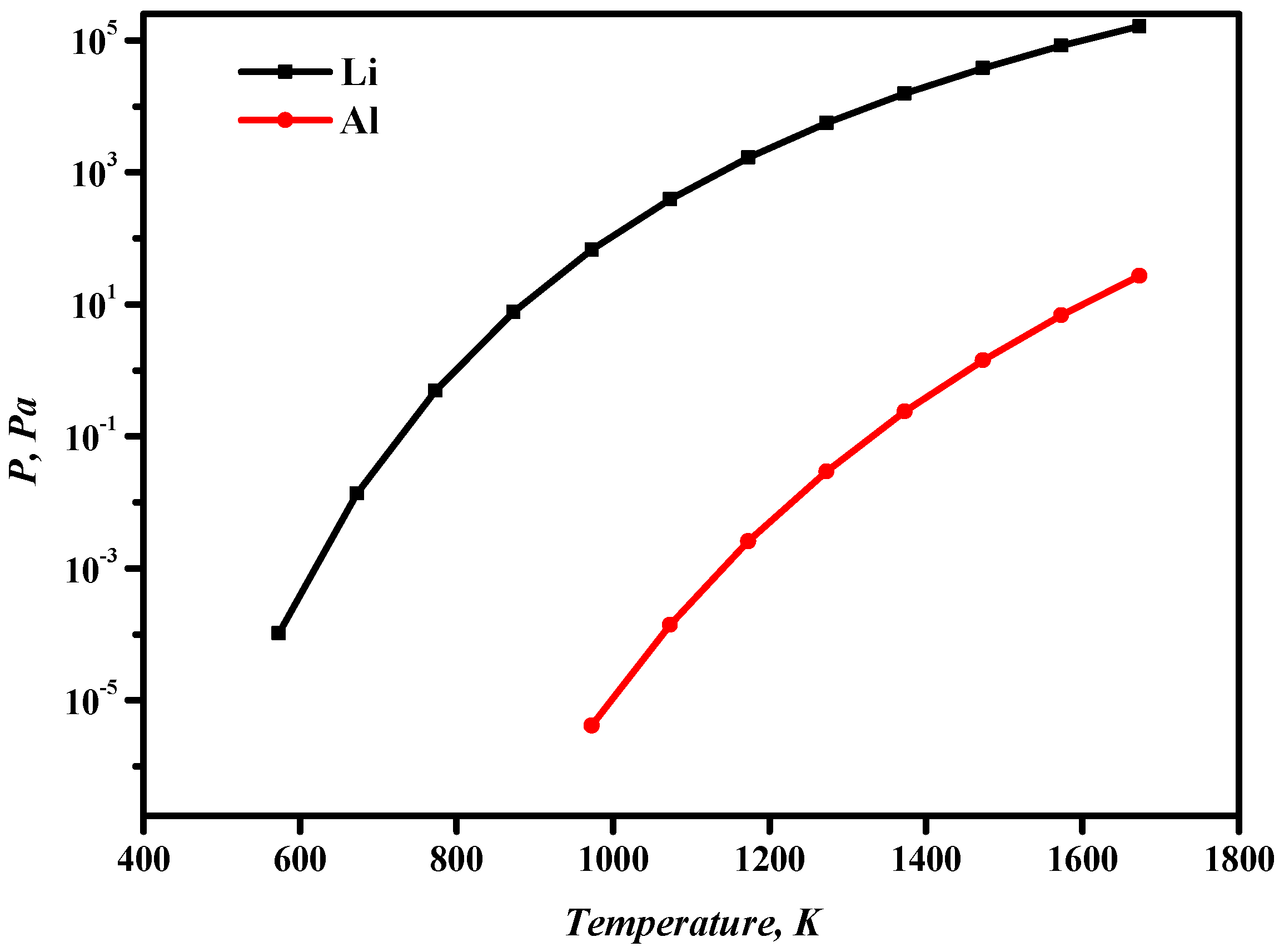
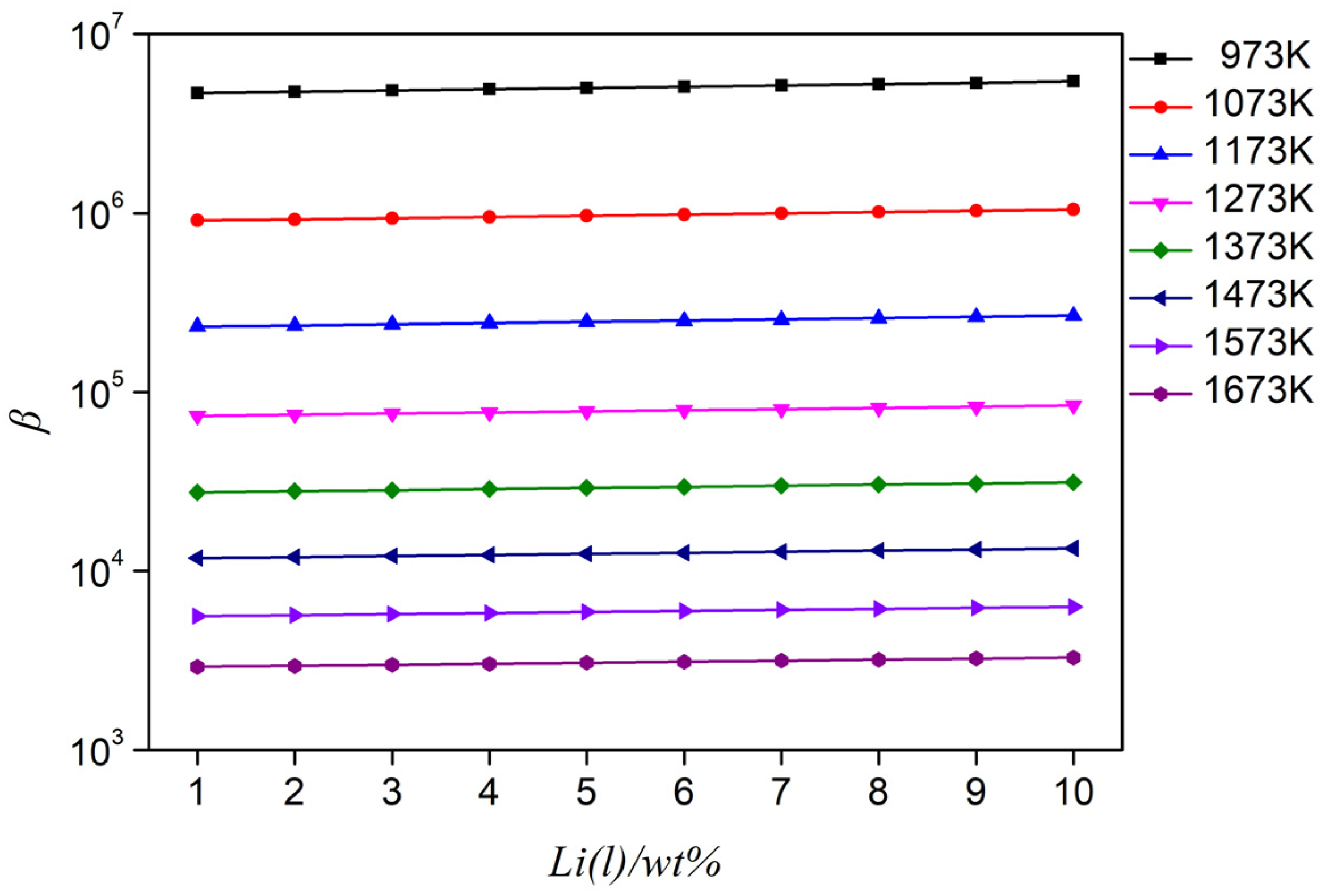
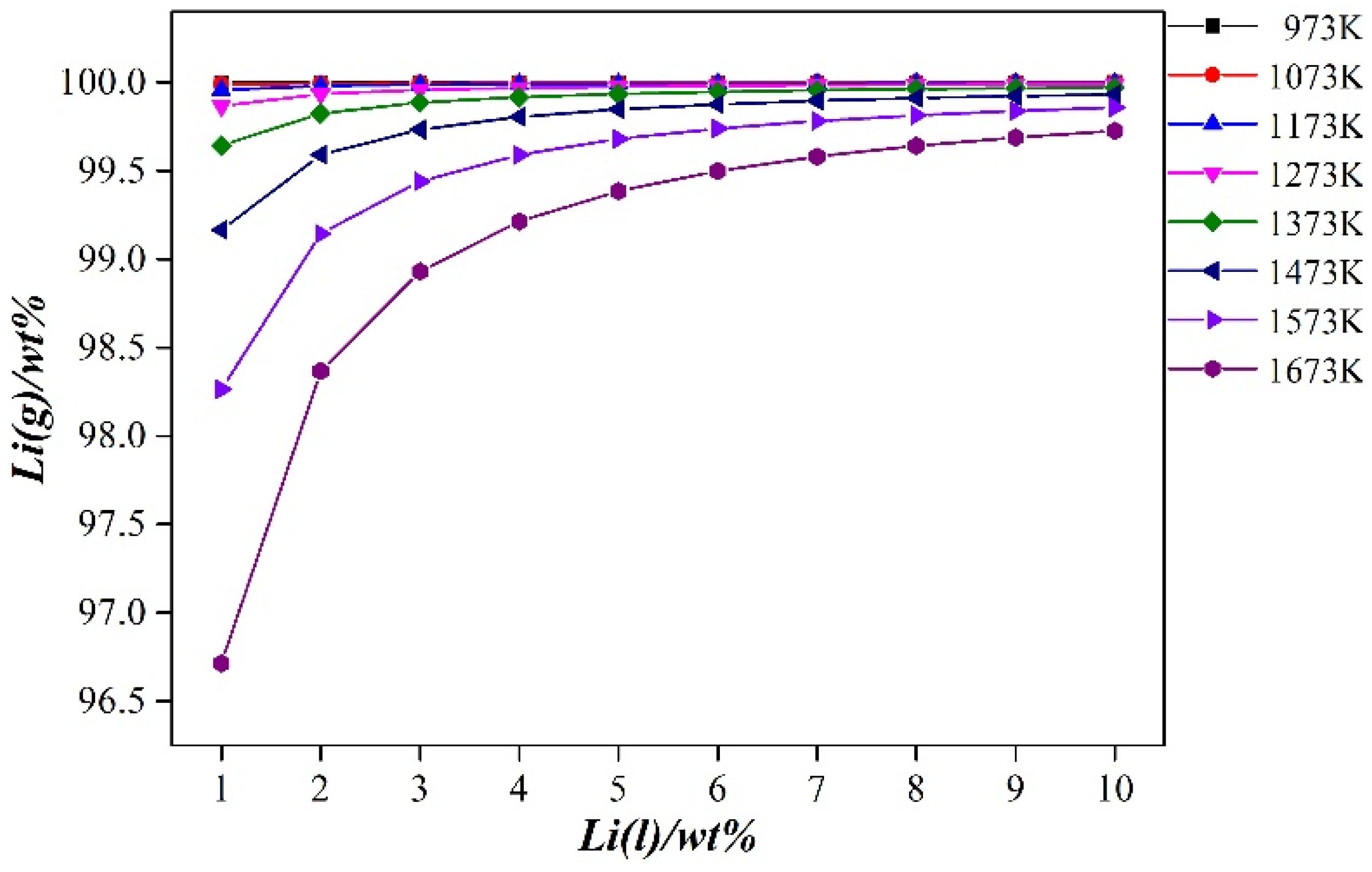
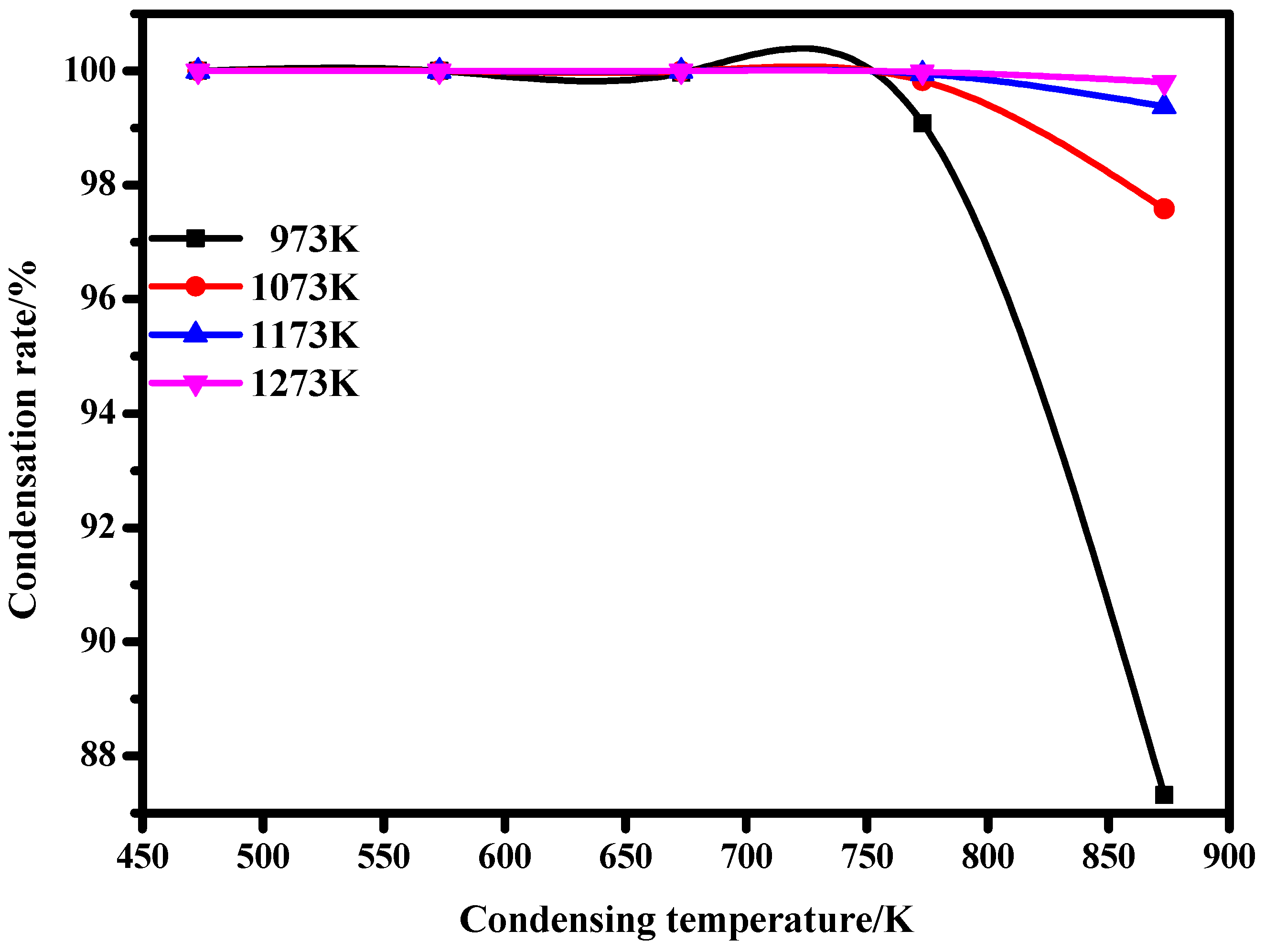
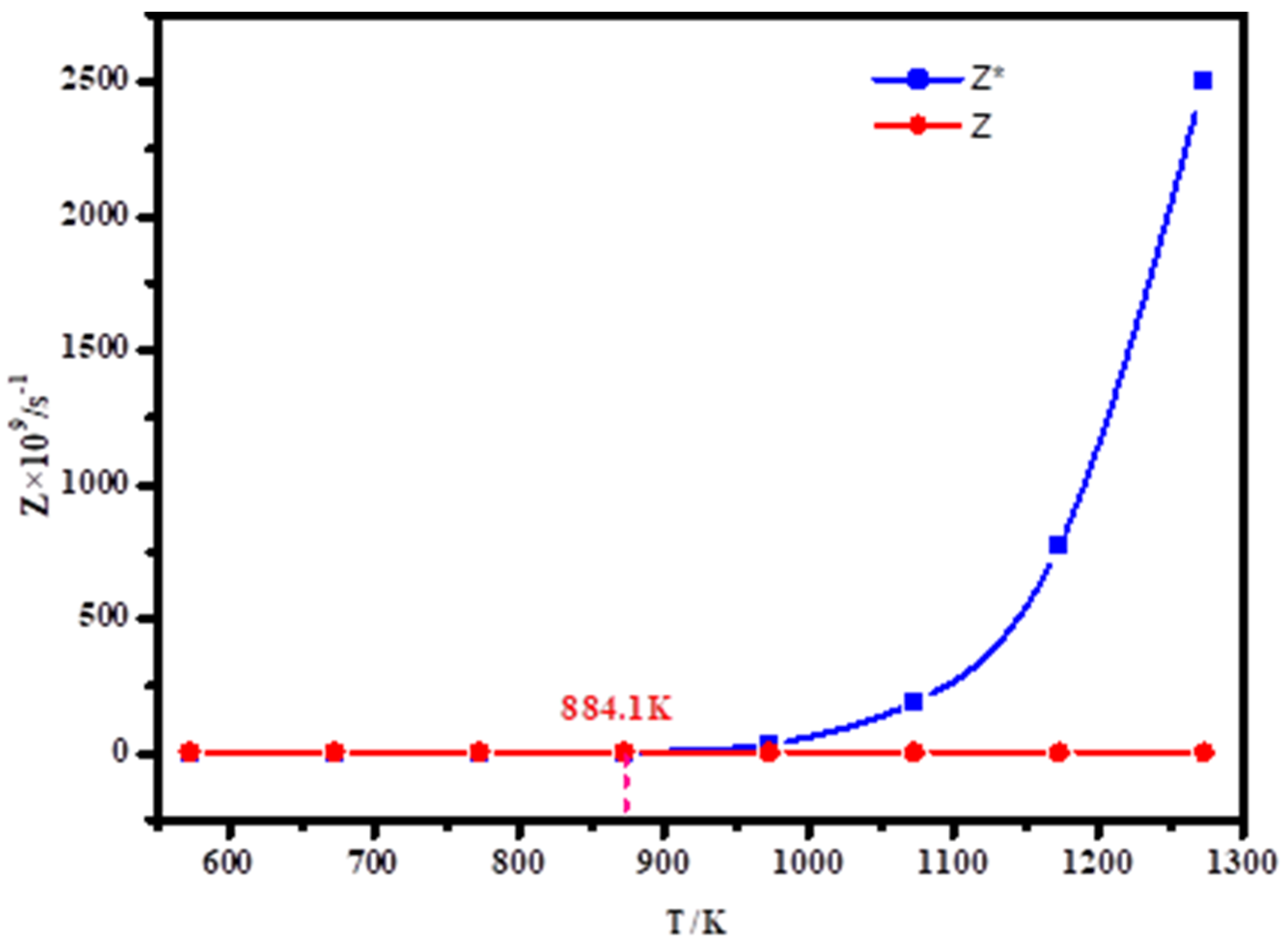
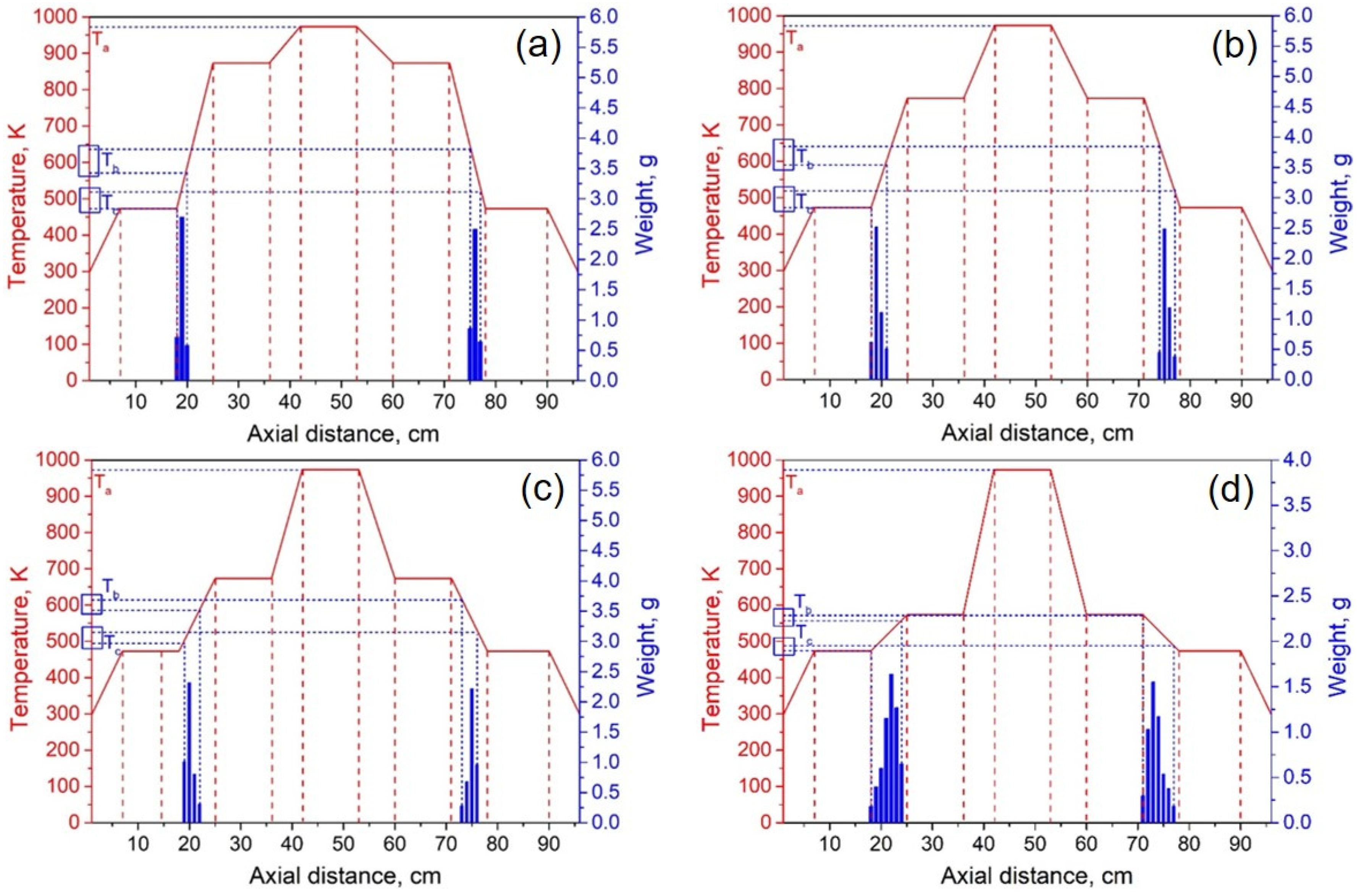
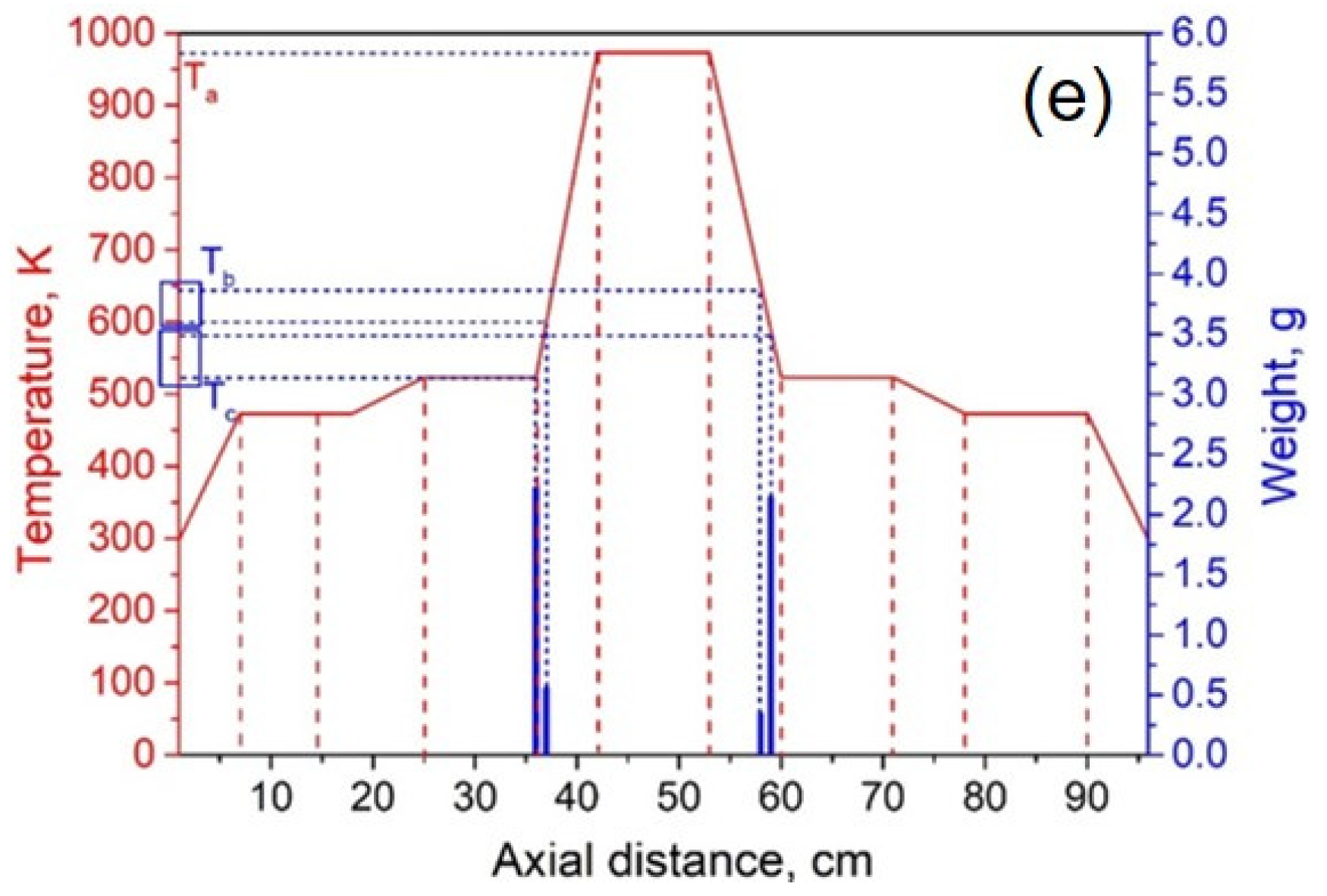
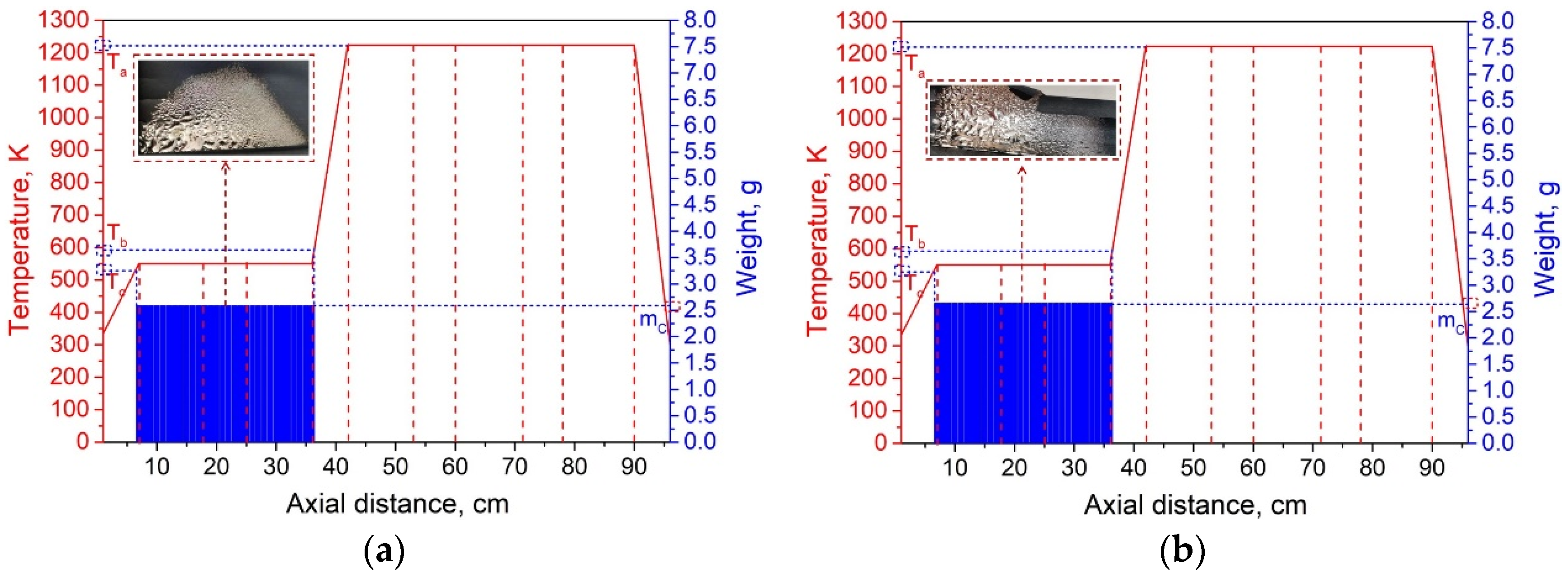
| T | 873 | 973 | 1073 | 1173 | 1273 |
| ρi | 0.0074 | 0.0583 | 0.3066 | 1.196 | 3.7176 |
| Element | Li | Na | Ca | Si | Fe | Al | Ni | K | Cu |
|---|---|---|---|---|---|---|---|---|---|
| Content | 99.9 | 0.04 | 0.0025 | 0.0056 | 0.0023 | 0.0005 | 0.0005 | 0.0011 | 0.0001 |
| Boiling Point | Metal | Pressure/Pa | ||||||||
|---|---|---|---|---|---|---|---|---|---|---|
| 1.33 × 10−4 | 1.33 × 10−3 | 1.33 × 10−2 | 1.33 × 10−1 | 1.33 | 1.33 × 101 | 1.33 × 102 | 1.33 × 103 | 1.33 × 104 | ||
| K | Li | 579 | 623 | 675 | 737 | 811 | 902 | 1017 | 1167 | 1371 |
| Al | 1039 | 1114 | 1200 | 1301 | 1421 | 1566 | 1745 | 1972 | 2269 | |
| Condensing Temperature/K | Condensation Rate | Distillation Temperature/K | |||
|---|---|---|---|---|---|
| 973 | 1073 | 1173 | 1273 | ||
| 473 | % | 99.9999997 | 99.9999999 | 100 | 100 |
| 573 | 99.9997354 | 99.9999497 | 99.9999871 | 99.9999959 | |
| 673 | 99.9708264 | 99.9944544 | 99.9985784 | 99.9995426 | |
| 773 | 99.0833182 | 99.825747 | 99.9553324 | 99.9856283 | |
| 873 | 87.3079522 | 97.5873553 | 99.381549 | 99.8010141 | |
| Number | Temperature /K | Raw Material/g | Residual | Condensate | Direct Yield of Li * | ||||
|---|---|---|---|---|---|---|---|---|---|
| Weight/g | Content of Al/% | Content of Li/% | Weight/g | Content of Al/% | Content of Li/% | ||||
| 1 | 1223 | 40.81 | 37.61 | 99.979 | 0.021 | 2.59 | 0.282 | 99.718 | 80.41 |
| 2 | 40.53 | 37.34 | 99.973 | 0.027 | 2.66 | 0.321 | 99.679 | 83.13 | |
Disclaimer/Publisher’s Note: The statements, opinions and data contained in all publications are solely those of the individual author(s) and contributor(s) and not of MDPI and/or the editor(s). MDPI and/or the editor(s) disclaim responsibility for any injury to people or property resulting from any ideas, methods, instructions or products referred to in the content. |
© 2023 by the authors. Licensee MDPI, Basel, Switzerland. This article is an open access article distributed under the terms and conditions of the Creative Commons Attribution (CC BY) license (https://creativecommons.org/licenses/by/4.0/).
Share and Cite
Shi, L.; Peng, Z.; Ning, P.; Sun, X.; Li, K.; Zhang, H.; Qu, T. Clean and Efficient Recovery of Lithium from Al-Li Alloys via Vacuum Fractional Condensation. Separations 2023, 10, 374. https://doi.org/10.3390/separations10070374
Shi L, Peng Z, Ning P, Sun X, Li K, Zhang H, Qu T. Clean and Efficient Recovery of Lithium from Al-Li Alloys via Vacuum Fractional Condensation. Separations. 2023; 10(7):374. https://doi.org/10.3390/separations10070374
Chicago/Turabian StyleShi, Lei, Zou Peng, Ping Ning, Xin Sun, Kai Li, Huan Zhang, and Tao Qu. 2023. "Clean and Efficient Recovery of Lithium from Al-Li Alloys via Vacuum Fractional Condensation" Separations 10, no. 7: 374. https://doi.org/10.3390/separations10070374
APA StyleShi, L., Peng, Z., Ning, P., Sun, X., Li, K., Zhang, H., & Qu, T. (2023). Clean and Efficient Recovery of Lithium from Al-Li Alloys via Vacuum Fractional Condensation. Separations, 10(7), 374. https://doi.org/10.3390/separations10070374








